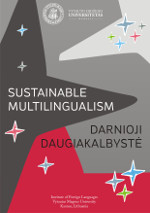LIMITS OF THE EU LANGUAGE EDUCATION POLICY FOR MIGRANTS: A COMPARATIVE STUDY OF THE VIETNAMESE MIGRANT COMMUNITY IN THE CZECH REPUBLIC AND THE NEW IMMIGRANTS IN TAIWAN
LIMITS OF THE EU LANGUAGE EDUCATION POLICY FOR MIGRANTS: A COMPARATIVE STUDY OF THE VIETNAMESE MIGRANT COMMUNITY IN THE CZECH REPUBLIC AND THE NEW IMMIGRANTS IN TAIWAN
Author(s): Melissa Shih-hui LinSubject(s): Education, Applied Linguistics, Migration Studies
Published by: Vytauto Didžiojo Universitetas
Keywords: Migration; linguistic integration; linguistic right; Vietnamese in Czech; European Union; Taiwan new immigrants;
Summary/Abstract: The aim of Council of Europe language education policies is to promote plurilingualism, linguistic diversity, mutual understanding, democratic citizenship and social cohesion. For migrant communities, the current approaches for linguistic integration are Linguistic Integration of Adult Migrants (LIAM) and Linguistic and Educational integration of children holding a migrant background. Nevertheless, due to the current refugee crisis in Europe, the realization of these strategies is quite limited and facing unexpected difficulties, which both are the core issues discussed in this paper. The Vietnamese arrived in Czech Republic in 1970s and 1980s as guest-workers. According to the 1985 census data from CZSO (Czech Statistical Office), there were 19,350 Vietnamese living in the Czech territory, but by 1994 the number decreased to approximately 8,000. Then, according to the census in 2014, due to the changes in both political and economic environment, the number of the Vietnamese in the Czech Republic increased from 18,210 to 52,612, spanning from 2001 to 2011. Nevertheless, this figure seems to greatly underestimate the real number of the Vietnamese living in the Czech Republic, mainly due to numerous undocumented immigrants of illegal migration. According to CZSO, the Vietnamese community constituted 12.5% of migrant population in the territory of the Czech Republic in 2014, serving as the third largest migrant community after Slovak and Ukraine communities. The Czech government conducts language policy programs for migrant integration, while the development has brought both positive and negative impact to the whole society, which will be further discussed in this paper and expanded into as an empirical study of the situation in the European context. The conclusion of this paper will enlist the problems and influence of Taiwan’s current new immigrant language education policy, serving as a reference for the current refugee crisis, along with specific focus on its linguistic integration in Europe.
Journal: Darnioji daugiakalbystė
- Issue Year: 2016
- Issue No: 9
- Page Range: 78-101
- Page Count: 24
- Language: English

